A guide to mortgages and Japanese knotweed
Homebuyers understand that Japanese knotweed is an invasive plant they should eliminate, but they often don’t realise that its presence can also complicate getting a mortgage
Quick Links
Quick facts
- Japanese knotweed is an invasive species of plant and its presence can affect whether or not you get a mortgage.
- Japanese knotweed is on the increase and the changing UK climate has made it even more of a problem in certain areas.
- It’s important to have your property surveyed if Japanese knotweed is present. The extent of growth and the risk to property can impact the mortgage valuation.
- Most lending companies will insist that you have a formal management plan with an insurance backed guarantee in place if Japanese knotweed is present.
Mortgage companies are concerned about Japanese knotweed because, over the course of a mortgage’s life, it could cause substantial damage if not controlled.
Getting a mortgage with Japanese knotweed on the property isn’t impossible but it does require having comprehensive plan in place. Let’s explore the available options and address the most common Japanese knotweed mortgage problems.
Getting a mortgage with Japanese knotweed
Estimates suggest that around 4 to 5% of homes in the UK experience issues with Japanese knotweed. While this might not sound like a lot, certain hotspots exist where encountering it is more probable. Purchasing a property in these areas can present problems.
If you’re selling a property you must check for knotweed and disclose any problems to potential buyers. If you’re unsure what it looks like, refer to our guide to spotting this invasive plant.
Unfortunately, Japanese knotweed is on the increase and has reportedly become more of a problem in certain areas. Recent research indicates that some mortgage companies have been overly cautious in the past when lending. We are however starting to see a relaxation in some lending criteria.
Although Japanese knotweed won’t result in an outright mortgage denial, you’ll need a management plan that addresses the concerns of the lending company. Some mortgage companies require a dedicated Japanese knotweed survey before granting a loan in hotspot areas.
While lenders might be cautious, obtaining a mortgage with Japanese knotweed on the property is still achievable. They’ll focus on ensuring the growth doesn’t harm the property and that its resale value remains intact in case of mortgage default.
If the plant is nearby but not on the property itself, there can be consequences. Generally, obtaining a mortgage for a house with Japanese knotweed in proximity depends on the perceived risk it poses. If the knotweed is more than 3 meters from your property’s boundary, securing a mortgage shouldn’t be an issue.
If the plant is on, or within 3m of the property, you should qualify for a mortgage provided you engage a certified company to manage the knotweed. This company must offer a warranty or guarantee backed by insurance, ensuring the knotweed won’t return over the next decade. Without a Japanese knotweed removal plan, it’s unlikely you’ll secure a mortgage.
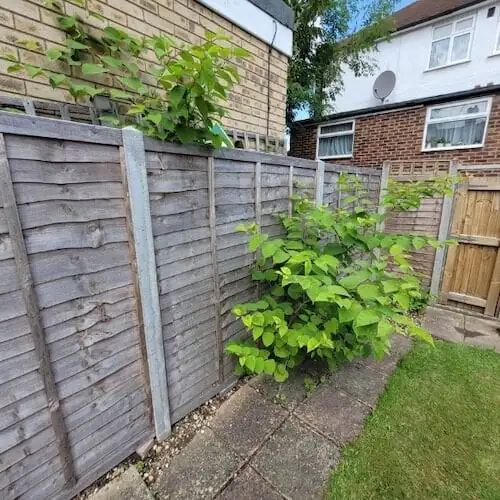

Japanese knotweed mortgage valuation
If you’re engaging a surveyor to assess the property you intend to purchase, you should reasonably expect their evaluation to encompass areas like the garden and its surroundings, searching for any indications of the plant. Placing complete reliance on the seller to acknowledge the presence of Japanese knotweed or to be entirely forthright about it may not always be dependable.
The mortgage valuation can be impacted by the extent of the infestation and the potential for damage to the building’s infrastructure.
While mortgage retentions are uncommon, it’s highly likely that if Japanese knotweed is identified on a property, a chartered surveyor would flag it as an issue. Subsequently, the lender would insist on implementing a management plan before finalising a mortgage offer.
Common Japanese knotweed mortgage problems
The most common Japanese knotweed mortgage issues are either not getting a lender to agree to the asking price or having to pay a higher rate of interest because of the problem. With Japanese knotweed, mortgage lenders can vary in approach depending on the RICS management category that the knotweed falls into.
Certain mainstream lenders maintain Japanese knotweed lending policies that require complete excavation of the invasive plant and a 10-year guarantee before the property can be sold. This can lead to noteworthy complications and delays, frequently arising at the final stages of a transaction—particularly if the seller lacks the financial means to carry out the necessary work before the completion.
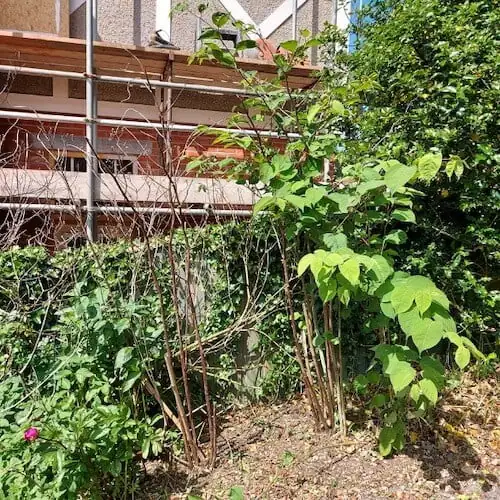

Buy-to-let mortgage with Japanese knotweed
If you’re applying for a buy-to-let mortgage, Japanese knotweed can be an issue for several reasons.
- For a start, finding a mortgage provider who will lend you money can be more difficult as you won’t be living at the property.
- Putting together a management plan for your mortgage company is also likely to add to the cost of your initial investment.
- Japanese knotweed on one property may impact your ability to get finance on another.
How to find a mortgage lender with Japanese knotweed
The Royal Institute of Chartered Surveyors (RICS) has recently revised its guidelines for mortgage companies when it comes to this invasive plant. The general view is that mortgage lenders’ policy on Japanese knotweed has been a little too cautious. While property damage is of primary concern this only happens in a very small number of cases.
In short, when it comes to Japanese knotweed and mortgage lenders, the presence of this plant shouldn’t stop you from shopping around for the best deal. You should have a full survey to identify the extent of the infestation and the recommended management strategy before you reach out.
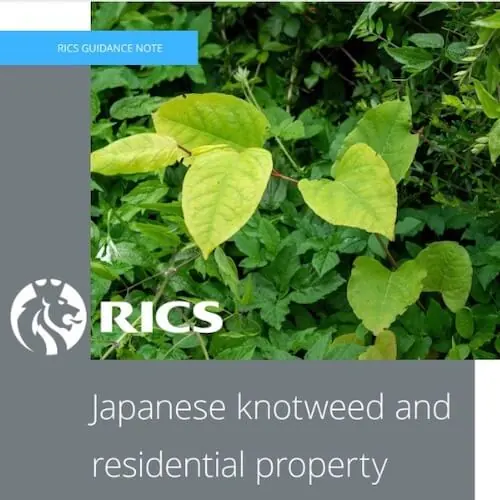
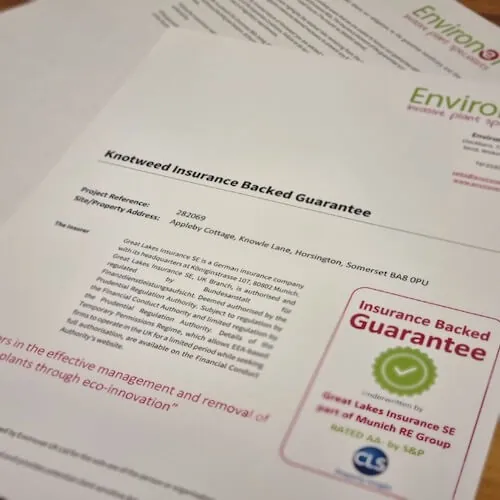
Banks and Japanese knotweed mortgages
Most popular banks have a clear policy when it comes to Japanese knotweed-related mortgages:
- HSBC Mortgage: Japanese knotweed should not have damaged infrastructure and the buyer needs to have a management plan in place.
- Nationwide Mortgage: Japanese knotweed that is causing material damage requires a specialist report and management plan. If there is no observable damage, then the buyer needs to acknowledge its presence and the potential for adverse effects if the infestation gets closer to the property.
- Halifax Mortgage: Japanese knotweed considerations are subject to the valuation and this needs to be done in conjunction with a report from a treatment company along with a management plan.
- NatWest Mortgage: Japanese knotweed is again assessed on the valuation and survey and completed in conjunction with a full report and proposed management plan.
- Santander Mortgage: Japanese knotweed is considered on a case-by-case basis for the bank and they seem to be more reticent about offering mortgages at the moment than other lenders.
- Barclays mortgage: Japanese knotweed that is within 7 metres must be investigated thoroughly by a specialist company offering a long-term management plan with an insurance-backed guarantee.
Japanese knotweed mortgage trends
There is no doubt that the way Japanese knotweed is looked at by mortgage companies, even over the past seven years, has changed. It’s worth keeping up to date if you are just starting to look for a home to buy.
- Japanese knotweed mortgage 2022: RICS released its new guidance on how surveyors should carry out preliminary assessments and how this should not ‘derail’ the sale of properties.
- Japanese knotweed mortgage 2020: RICS began working on its revised advice for mortgage companies and Japanese knotweed.
- Japanese knotweed mortgage 2019: The RICS were asking for better research on the impact of Japanese knotweed, potentially taking the more relaxed approaches other countries seem to have with this invasive plant.
- Japanese knotweed mortgage 2018: A report by Fennel showed that Japanese knotweed is less likely to cause damage to infrastructure than trees.
- Japanese knotweed mortgage 2017: Properties near rail lines that were infested with Japanese knotweed had difficulty in getting mortgages. This was mainly because of Network Rail’s reticence in showing potential buyers their plans for eradicating the problem.
- Japanese knotweed mortgage 2016: If a mortgage valuation expert noticed Japanese knotweed more than 3 metres outside the perimeter of the property, they were not, according to the RICS, duty bound to mention it to the potential lender.
- Japanese knotweed mortgage 2015: Legislation changed to allow the Environment Agency to take action against landowners who had previously ignored requests to solve their knotweed problem. Some lenders would still not allow a mortgage if knotweed was identified outside the property.
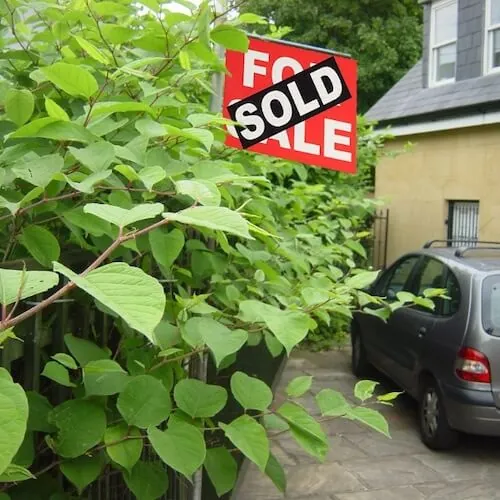
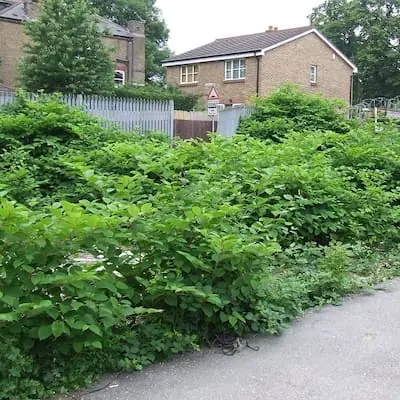
Japanese knotweed mortgage FAQs
Yes. In the last few years, mortgage companies have become more relaxed following guidance from the RICS. If Japanese knotweed is present, a mortgage lender will usually ask for a site survey and management plan supported by an insurance-backed guarantee.
Yes. Much will depend on the extent of the infestation and whether it has invaded the structure of the property. You will also need a professional management plan in place with an insurance-backed guarantee.
Potentially they can, but most banks nowadays have set processes in place for checking buildings thoroughly and it’s unlikely to happen.
If there is Japanese knotweed on the property, a mortgage can be given if you have a suitable management plan in place. The only issue occurs when the knotweed has already caused damage to the infrastructure of the property as this could dramatically affect the sale price.
In certain circumstances, it can stop you from getting a mortgage. This is usually the case if the knotweed has become so invasive that it has damaged the infrastructure of the building and walls themselves. In most cases, as long as you have a management plan in place, there shouldn’t be a problem.
Yes. The majority of banks and mortgage lending companies have specific prerequisites in place for properties that have Japanese knotweed. This includes carrying out a full survey and putting in place a management plan that is covered by an insurance-backed guarantee.
Start fixing your invasive plant problem today by requesting a survey
Request a survey
Rest assured, where invasive species are identified at an early stage and tackled correctly, problems can usually be avoided. Our specialist consultants complete thorough surveys to identify the extent of the problem. Our plans aren’t one-size-fits-all; they’re customised to tackle the invasive species at your property effectively, taking account of all of your requirements.
GET IN TOUCH
Contact us
Our team of experts is available between 9am and 5:30pm, Monday to Friday to answer your enquiries and advise you on the next steps
Want a survey?
If you already know you have an invasive plant problem, you can request a survey online in less than two minutes by providing a few brief details. A member of the team will swiftly come back to you with further information and our availability.
Need quick plant identification?
Simply upload a few images of your problem plant to our identification form and one of our invasive plant experts will take a look and let you know, free of charge what you are dealing with. We’ll also be there to help with next steps where necessary.



